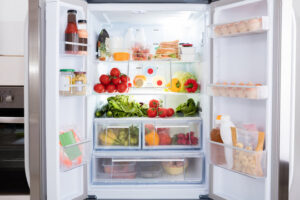

A puddle of water under your refrigerator can signal a range of issues, from simple maintenance problems to potentially expensive repair needs. Understanding the root causes of refrigerator leaks empowers you to address minor issues before they escalate into costly water damage affecting your flooring, cabinets, and surrounding areas. This comprehensive guide walks you through the most common causes of refrigerator water leaks, provides step-by-step troubleshooting instructions, and reveals how modern intelligent leak detection technology can prevent future problems and protect your home investment.

Refrigerator leaks typically stem from six primary sources, each with distinct symptoms and solutions. The most frequent culprit is a clogged defrost drain, which prevents condensation from draining properly and causes water to pool inside the refrigerator or leak onto the floor.
Primary Leak Sources:
These issues often develop gradually, starting with minor moisture buildup that eventually becomes visible puddles. Early detection, which is key to preventing escalation into major water damage that can cost thousands in repairs to flooring, cabinetry, and surrounding structures, makes you feel proactive and in control of your home maintenance.
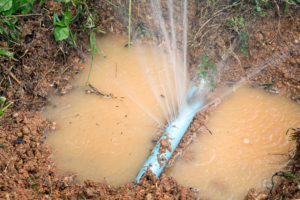
Initial Safety and Inspection Steps: Begin by unplugging the refrigerator and removing any standing water to prevent electrical hazards and further damage. Inspect the area around and behind the refrigerator for the source of moisture, noting whether water appears to come from underneath, behind, or inside the unit.
Systematic Component Checking
Simple DIY Fixes You Can Try
When troubleshooting reveals electrical components, internal water lines, or recurring issues despite repairs, professional service becomes necessary to avoid safety risks and ensure proper resolution.
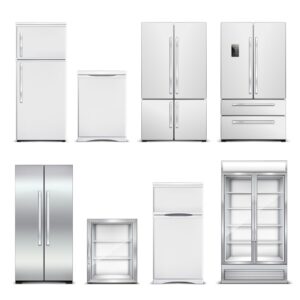
Drain Pan Problems The drain pan collects condensation from the defrost cycle and relies on evaporation to prevent overflow. Cracked pans leak directly onto the floor, while improperly positioned pans fail to catch drainage effectively. Replacement drain pans typically cost $30-$ 60, plus the cost of installation.
Water Inlet Valve Failures. This component controls water flow to ice makers and dispensers, with internal failures causing continuous water flow and leaks. Symptoms include constant water dripping, unusual humming sounds, or water pooling near the back of the refrigerator. Professional replacement typically costs $150-$ 300.
Door Gasket Deterioration: Worn or damaged door seals allow warm, humid air into the refrigerator, creating excess condensation that overwhelms the drainage system. Replacement gaskets range from $50 to $150, depending on refrigerator model and configuration.
Defrost System Components Defrost heaters, thermostats, and control boards affect ice buildup and drainage patterns. When these components malfunction, excess ice blocks drainage pathways, causing water to overflow into unexpected areas.
Understanding replacement costs helps determine whether repairs make financial sense compared to replacing the refrigerator, particularly for units over 8-10 years old, where multiple component failures may indicate broader system deterioration.
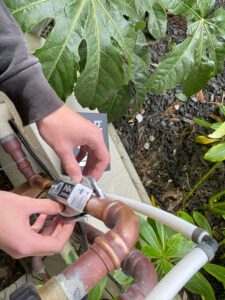
Regular Maintenance Schedule: Monthly inspections of visible components prevent most leak situations, making you feel responsible and proactive. Check door seals, clean exterior coils, and flush defrost drains with warm water to remove debris buildup. Quarterly deep cleaning includes moving the refrigerator to inspect the water connections and the condition of the drain pan.
Environmental Controls: Maintain consistent kitchen humidity levels and avoid placing hot items directly into the refrigerator, which creates excess condensation. Ensure adequate clearance around the refrigerator for proper air circulation and cooling system operation.
Smart Leak Detection Integration The new Bluebot Mini provides residential-scale water monitoring that instantly detects and alerts of most larger refrigerator leaks above 0.25 GPM before they cause extensive damage. This compact system monitors water flow patterns throughout your home, sending immediate alerts when unusual activity suggests appliance leaks or other plumbing issues.
Unlike traditional point sensors that only detect water after it reaches floor level, the Bluebot Mini monitors your entire water system, identifying refrigerator leaks through abnormal usage patterns even when water remains contained within appliance areas. However, the use of a flow meter may not catch everything. Small drips may in some cases be undetectable and it is recommended, if this is a major concern, to add a moisture sensor “puck type” water alert device under the refrigerator in addition to the water meter for more comprehensive protection. In the same way a broken toilet gasket can be running flow continuously and the flowmeter will immediately alert, an older toilet that drips from the basin will set off the moisture sensor. It should be noted that the most costly leak, and one that can create the most property damage, is a leak with a high flow rate.
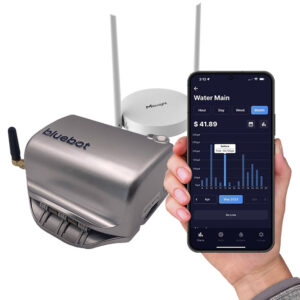
Progressive Water Damage: Small leaks allow moisture to seep into flooring materials, cabinet bases, and wall structures. Wood flooring warps and buckles, while laminate flooring swells and separates. Subfloor damage often requires complete replacement, with costs ranging from $3 to $8 per square foot plus labor. Failing to address these leaks can result in significant financial losses, making it essential to address them promptly.
Mold and Health Risks: Persistent moisture in dark, warm areas creates ideal conditions for mold growth. Mold damage requires professional remediation, costing $ 2,000-$6,000+ depending on the extent of contamination. Health impacts include respiratory problems, allergic reactions, and complications for individuals with weakened immune systems.
Unaddressed water damage can leave permanent stains, odors, and structural issues that reduce property values and complicate future sales. Insurance companies may deny claims for gradual damage that could have been prevented through proper maintenance and care.
The most common causes of water leaks in homes include appliance failures, such as refrigerator leaks, making early detection crucial for protecting your investment and avoiding costly repairs.
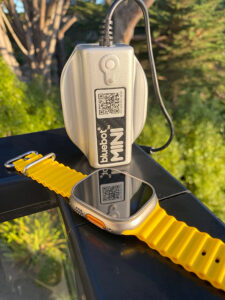
Early Detection Indicators
Visual Inspection Clues: Check for water stains on nearby walls or cabinets, warped flooring materials, or mineral deposits around water line connections. Door gaskets showing wear, cracking, or poor sealing indicate potential future leak sources.
Performance Changes: Ice makers producing less ice, water dispensers flowing irregularly, or increased energy bills can signal developing problems that may lead to leaks. Address these symptoms promptly to prevent them from escalating.
Intelligent monitoring systems, such as the Bluebot Mini, detect these subtle changes in water usage patterns, providing early warnings before visible leaks develop and cause damage.
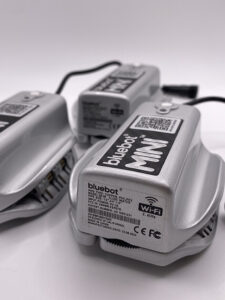
Complex internal issues, such as refrigerant line problems, electronic control failures, or access to internal components, require specialized tools and training. Attempting DIY repairs on these systems can void warranties, create safety hazards, or cause additional damage that exceeds the original repair costs.
Recurring Leak Problems When repairs fail to resolve leaking issues or problems return within weeks, underlying causes require professional diagnosis. Multiple component failures often indicate system-wide problems that are best addressed through a comprehensive evaluation.
Safety Concerns: Electrical components near water pose shock risks, while handling refrigerant requires proper certification and specialized equipment. Professional technicians receive specialized training and utilize specialized tools to address these hazardous situations safely.
Cost-Benefit Analysis: Professional repairs typically cost $150-$ 400 for common issues, while major component replacements can range from $500 to $ 800. For refrigerators over 10 years old, replacement may provide better long-term value than expensive repairs.
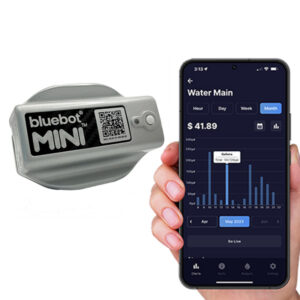
Whole-Home Leak Detection Traditional point sensors only detect water after it reaches floor level, often too late to prevent significant damage. The Bluebot Mini monitors your entire water system throughout your entire house, identifying abnormal usage patterns that indicate appliance leaks before water spreads.
Real-Time Alert System: Instant smartphone notifications enable an immediate response to developing leaks, even when you’re away from home. This early warning capability prevents minor appliance issues from becoming major water damage claims.
Usage Pattern Analysis: Smart monitoring reveals baseline water consumption patterns, making unusual activity, such as refrigerator leaks, immediately apparent. Historical data helps identify gradual changes that indicate the development of problems.
Integration Benefits: The system works seamlessly alongside existing smart home technology, providing comprehensive property protection that extends beyond just leak detection. Smart water leak sensors complement whole-home monitoring for complete coverage.
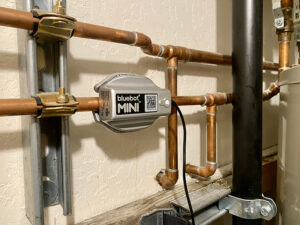
Refrigerator leaks represent one of the most preventable sources of home water damage, yet they cause thousands of dollars in repairs annually when left unaddressed. Understanding common causes, implementing regular maintenance routines, and utilizing innovative detection technology create multiple layers of protection for your property.
The combination of proactive maintenance and intelligent monitoring systems, such as the Bluebot Mini, provides peace of mind and financial protection against unexpected appliance failures. Early detection saves money, prevents property damage, and maintains your home’s value through preventive care rather than reactive repairs.
Modern leak detection technology transforms home protection from reactive damage control to proactive prevention, making refrigerator leaks a manageable maintenance issue rather than a costly emergency.
Ready to protect your home from costly refrigerator leaks and water damage?
Discover how the Bluebot Mini intelligent water monitoring system provides 24/7 leak detection and instant alerts, preventing minor appliance issues from escalating into major repair bills.